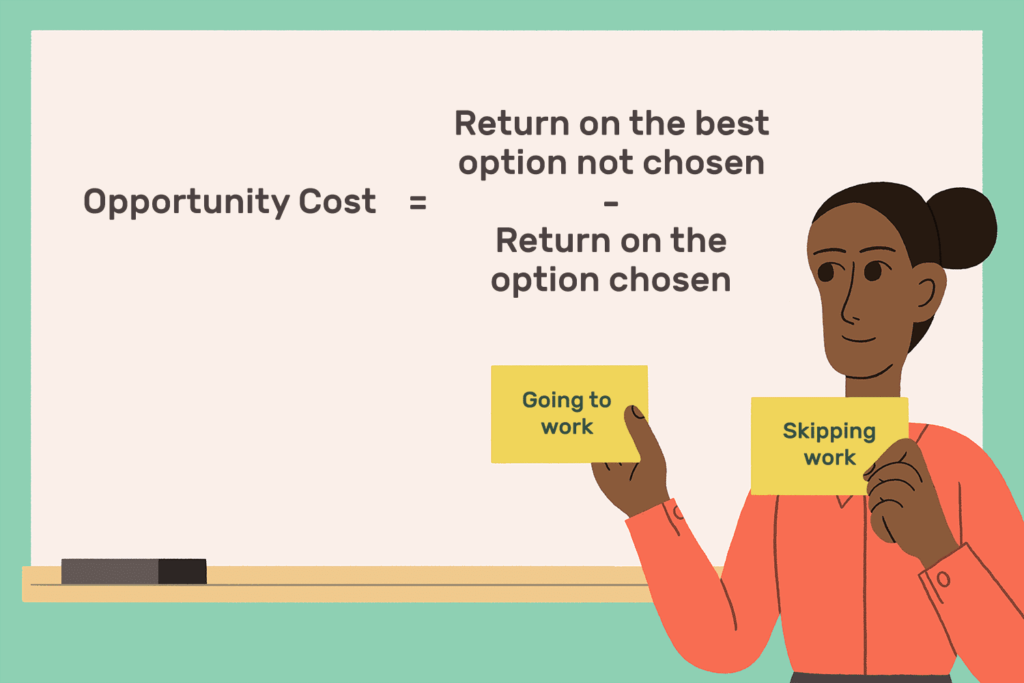
In a world where financial decisions can make or break our future, understanding the concept of opportunity cost of saving money becomes crucial. When it comes to saving money, we often focus solely on the benefits, but have you ever considered what you might be giving up in the process? 🤔
The opportunity cost of saving money is a hidden factor that many overlook, yet it plays a significant role in shaping our financial landscape. It’s not just about the dollars and cents you’re setting aside; it’s about the potential gains or experiences you’re forgoing in the present. From short-term sacrifices to long-term rewards, the journey of saving money is filled with trade-offs that deserve careful consideration.
Understanding Opportunity Cost in Savings
Definition of opportunity cost
Opportunity cost refers to the potential benefits or value forgone when choosing one alternative over another. In the context of saving money, it represents the value of what you give up by deciding to save rather than spend or invest elsewhere.
The trade-off between saving and spending
When considering saving money, individuals face a trade-off between immediate gratification and future financial security. By choosing to save, one foregoes the immediate pleasure or utility that could be derived from spending that money on goods, services, or experiences. This trade-off highlights the essence of opportunity cost in personal finance decisions.
How it applies to saving money
Opportunity cost applies to saving money in several ways:
-
- Immediate consumption: By saving, you forgo the immediate enjoyment or utility of purchasing goods or services.
-
- Alternative investments: The money saved could potentially earn higher returns if invested in stocks, real estate, or other assets.
-
- Time value of money: Saving for the future means potentially missing out on experiences or opportunities in the present.
-
- Inflation considerations: The purchasing power of saved money may decrease over time due to inflation, representing an opportunity cost.
Understanding the opportunity cost of saving money helps individuals make informed decisions about their financial resources.
Short-Term Opportunity Costs of Saving
When considering the opportunity cost of saving money, it’s crucial to understand the short-term trade-offs involved. While saving is generally beneficial for long-term financial health, it can come with immediate opportunity costs that impact daily life.
Impact on Quality of Life
opportunity cost of Saving money often requires foregoing certain luxuries or experiences in the present. This can lead to a perceived reduction in the quality of life, as individuals may need to:
-
- Limit dining out or entertainment expenses
-
- Postpone vacations or travel plans
-
- Delay purchasing non-essential items
-
- Opt for more affordable housing or transportation options
Reduced Current Consumption
One of the most tangible opportunity costs is the reduction in current consumption. By allocating funds towards savings, individuals have less disposable income for immediate use. This can manifest in various ways:
-
- Decreased spending on discretionary items
-
- Choosing lower-cost alternatives for necessary purchases
-
- Limiting social activities that involve spending
-
- Postponing upgrades to technology or household items
Long-Term Benefits of Saving
When considering the opportunity cost of it’s crucial to understand the long-term benefits that can significantly outweigh short-term sacrifices. These advantages demonstrate why saving money is often a wise financial decision.
Ability to make larger future purchases
Saving money consistently over time enables individuals to accumulate substantial funds for significant future expenditures. This financial discipline allows for the pursuit of major life goals without relying on high-interest loans or credit. Whether it’s purchasing a home, funding higher education, or starting a business, having a robust savings account provides the necessary capital to make these larger purchases a reality.
Compound interest growth
One of the most powerful benefits of long-term saving is the effect of compound interest. As savings accumulate, the interest earned on the initial principal also begins to generate its own interest, creating a snowball effect that accelerates wealth growth over time. This exponential growth can significantly increase the overall value of savings, particularly when funds are left untouched for extended periods.
Maximizing Returns on Savings
Now that we’ve explored the long-term benefits of saving, let’s dive into strategies for maximizing returns on your savings. By strategically allocating your funds, you can potentially offset the opportunity cost.
Real Estate and Other Assets
Investing in real estate or other tangible assets can be an effective way to maximize returns on savings. Real estate often appreciates over time and can provide rental income, potentially outpacing inflation and offering better returns than traditional savings accounts. Other assets, such as art or collectibles, may also appreciate in value, though they typically require more specialized knowledge.
Retirement Accounts
Utilizing retirement accounts like 401(k)s or IRAs can significantly boost your savings’ growth potential. These accounts often offer tax advantages and may include employer matching contributions, effectively increasing your savings rate. By capitalizing on compound interest over the long term, retirement accounts can help mitigate the opportunity cost of saving money.
Investment Opportunities
Exploring various investment opportunities can help maximize returns on savings. It includes stocks, bonds, mutual funds, or exchange-traded funds (ETFs). Diversifying your investment portfolio can help balance risk and potential returns, potentially outperforming traditional savings methods. However, it’s crucial to understand that investments come with their own set of risks and opportunity costs.
High-Yield Savings Accounts
For those seeking a lower-risk option, high-yield savings accounts offer better interest rates than traditional savings accounts. While the returns may not be as high as other investment options, these accounts provide a balance between accessibility and improved interest rates, helping to reduce the opportunity cost of saving money.
Formula of Calculating Opportunity Cost
The formula for calculating opportunity cost is straightforward yet powerful in understanding the true cost of financial decisions. To calculate opportunity cost, use the following formula:
“Opportunity Cost = Value of the Next Best Alternative – Value of the Chosen Option”
This formula helps quantify the potential benefits foregone when making a particular choice. In the context of saving money, it can be applied as follows:
Application to Saving Money
When considering the opportunity cost of saving money, the formula can be adapted:
Opportunity Cost of Saving = Potential Return on Investment – Interest Earned on Savings
For example, if you choose to save $1,000 in a savings account earning 1% interest instead of investing it in stocks with a potential 7% return:
Opportunity Cost = (7% of $1,000) – (1% of $1,000) = $70 – $10 = $60
This calculation reveals that the opportunity cost of saving in this scenario is $60, representing the additional return you could have earned by investing.
Considerations When Calculating
It’s important to note that opportunity cost calculations often involve estimations and assumptions about future returns. Factors to consider include:
-
- Risk tolerance
-
- Time horizon
-
- Liquidity needs
-
- Economic conditions
By using this formula and considering these factors, individuals can make more informed decisions about saving versus investing, balancing short-term security with long-term financial growth potential.
Example of Opportunity Cost in Investing
Opportunity cost plays a crucial role in investment decisions, illustrating the potential gains foregone when choosing one investment option over another. A prime example of opportunity cost in investing is the decision between investing in stocks or bonds.
Consider an investor who has $10,000 to invest and is deciding between a stock portfolio with an expected annual return of 10% and a bond fund yielding 5% annually. If the investor chooses the bond fund, the opportunity cost would be the 5% additional return they could have earned by investing in stocks.
Another example involves real estate investment. An individual might have the option to purchase a rental property or invest in a diversified stock portfolio. If they choose the rental property, the opportunity cost would be the potential returns from the stock market, as well as the time and effort required to manage the property.
Opportunity cost also applies to timing investment decisions. For instance, an investor might hesitate to invest in a promising startup, only to see its value skyrocket months later. The opportunity cost here is the missed potential gains from not investing earlier.
A Production Possibility Chart Assist in Outlining Opportunity Cost
A production possibility chart, also known as a production possibility frontier (PPF), is a powerful tool that visually represents the concept of opportunity cost in economics. This chart illustrates the trade-offs between producing two different goods or services with limited resources.
Visualizing Trade-offs
The PPF curve shows all possible combinations of two goods that can be produced given fixed resources and technology. Each point on the curve represents a maximum efficient production level for both goods. As you move along the curve, you can see how increasing the production of one good necessitates decreasing the production of the other.
Quantifying Opportunity Cost
By examining the slope of the PPF curve at any given point, economists can quantify the opportunity cost. The slope represents how many units of one good must be given up to produce one more unit of the other good. This tangible representation helps in understanding the real-world implications of resource allocation decisions.
Demonstrating Efficiency and Scarcity
Points inside the curve indicate inefficient production, while points outside the curve are unattainable given current resources and technology. This visual representation effectively illustrates the economic concepts of efficiency and scarcity, which are fundamental to understanding opportunity cost.
Analyzing Economic Growth
Shifts in the PPF curve can represent economic growth or technological advancements. An outward shift indicates increased production possibilities, while an inward shift might represent a decrease in resources or production capacity. These shifts help in analyzing how changes in an economy affect opportunity costs over time.
Now that we’ve explored how production possibility charts illuminate opportunity cost, let’s examine a practical example of opportunity cost in investing.
The Benefits and Opportunity Costs of Spending and Saving
Understanding the balance between spending and saving is crucial for effective financial management. Both activities come with their own set of benefits and opportunity costs, which can significantly impact your financial well-being.
When it comes to spending, the immediate benefit is the satisfaction derived from purchasing goods or services. This can include necessities like food and shelter, as well as discretionary items that enhance your quality of life. The opportunity cost of spending, however, is the potential future value of that money if it were saved or invested instead.
On the other hand, saving money offers several advantages. It provides financial security, helps build an emergency fund, and allows for future large purchases or investments. The opportunity cost of saving is the immediate gratification or utility you forgo by not spending the money now.
Calculating the opportunity cost of saving money involves considering the potential returns on investment versus the benefits of immediate spending. For instance, if you save $1,000 instead of spending it on a vacation, the opportunity cost is the enjoyment you miss out on. However, if that $1,000 is invested and grows to $1,500 over time, the opportunity cost of spending would have been $500 in potential earnings.
Balancing spending and saving requires careful consideration of your financial goals, risk tolerance, and current economic conditions. By understanding the opportunity costs associated with each decision, you can make more informed choices about how to allocate your resources effectively.
Conclusion
Opportunity cost plays a crucial role in financial decision-making, particularly when it comes to saving money. By understanding the short-term sacrifices and long-term benefits associated with saving, individuals can make more informed choices about their financial future. Calculating opportunity cost and utilizing tools like production possibility charts can provide valuable insights into the trade-offs between spending and saving.
Ultimately, striking a balance between saving and spending is essential for financial well-being. While saving offers security and future opportunities, it’s important to recognize that excessive saving may lead to missed experiences or investments. By carefully considering the opportunity costs and potential returns, individuals can develop a savings strategy that aligns with their goals and maximizes their financial potential.


